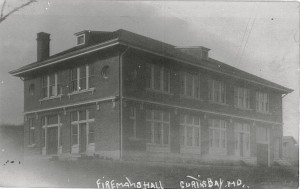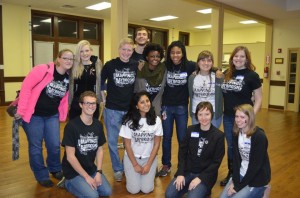Social entrepreneurship in the public history classroom
21 December 2012 – Nicole King
During the fall 2012 semester, I taught the third iteration of my undergraduate research seminar “Preserving Places, Making Spaces in Baltimore” for the Department of American Studies at UMBC. The class is designed to expose students to historical documentation skills as well as business practices that can be used in the non-profit world.
A 2008 Faculty Innovation Grant from the Kauffman Foundation continues to function as the seed money for the course, but students must use the money in an entrepreneurial way that produces revenue for a local non-profit partner. Students must plan and execute the class project and a final event to debut our research at a community space.
All offerings of the course so far have focused on the cultural history of a struggling industrial community in South Baltimore referred to as Baybrook, the term used when referring to the two neighborhoods of Brooklyn and Curtis Bay together. Early in the semester, students learn the methods of oral history and cultural documentation. Even more centrally, students attend community meetings and events that expose them to the people living and working in the area we study.
Once students are familiar with the methods of documentation and the community where we will be working, they must develop a theme for the class project. This semester a student’s feasibility study on the historic main streets—Patapsco Avenue in Brooklyn and Pennington Avenue in Curtis Bay—received the most support. Once we had a focus, students worked to develop a name for the project—Mapping Baybrook: From Main Street to the Harbor—and producing a mission statement, strategic plan, committee structure, and a budget. Students used city directories, criss cross directories, Sanborn maps, and other primary resources to collect information on each main street block. Then they researched the stories behind these places. Student research is archived on the Mapping Baybrook website.
This semester, visual arts professor Steve Bradley and I received an additional Breaking Ground grant from UMBC, which enabled our two classes to work together on the project. Bradley’s students worked with local high school students and a group of seniors to create collaborative art projects focused on the sense of place in Baybrook. The American studies and visual arts students worked within their own disciplines while also collaborating on our end-of-the-semester event at the Polish Home Hall, which is listed on the National Register of Historic Places, in Curtis Bay.
Entrepreneurship and collaboration between the two classes was not only present at the final event. Throughout the semester the visual arts students did design work for my students, who functioned as clients. For example, my students described a logo they wanted designed for the project and a visual arts student executed it. The logo was used on the t-shirts my students sold. Students also sold buttons, held fundraisers at the university, and sold ads for the event program and $10 tickets to the event.

Polish Home Hall, 1915
On Saturday December 1, the first floor of the Polish Home Hall was filled with music, food, public history projects, and the sounds of over 100 people gathered to socialize and celebrate Baybrook’s history. The second floor provided a space for quiet reflection for people to view the art exhibit of the visual arts class. We raised $1,200 that day (while also sustaining our original $1,500 seed money) to donate to the Baybrook Coalition for the continued preservation of the Polish Home Hall.
Even more important than the money we raised, we successfully brought the community together. Old friends and even lost loves were reunited at the event. The stories my students and I heard on that day were priceless. The most successful aspects of this course it that it pushes students to think about the intangibles of culture in a very tangible way.
In conclusion, I must admit that the tangible aspects of this course can produce a great deal of anxiety, last minute problems, and near-tragic moments. For example, an elderly woman, who was not even attending the event, fell down outside of the hall and entered looking for help. A student who is also a trained EMT was working the door took her to the bathroom but was unable to stop the bleeding. Once I was alerted, I got one student to guard the bathroom door and one student to run a block down the street to the fire department.
The music of the Curtis Bay Seniors performing holiday tunes almost completely overshadowed the siren from the fire truck. The woman was helped and the event moved forward with few people even noticing. However, this was one of the students’ favorite stories from the day. We came together, and everyone survived. This moment really has nothing to do with history, through it directly engages what it means to be human. This is really what the humanities are about.
Yes, if you leave the classroom, things often do get messy. However, messy can be a good thing—or at least inevitable in history and non-profit work. That alone is an important lesson.
~ Nicole King, UMBC





1 comment